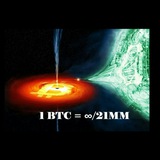This media is not supported in your browser
VIEW IN TELEGRAM
Instituto Rothbard Brasil
E se o criador do Bitcoin, Satoshi Nakamoto, voltasse? - Instituto Rothbard Brasil
Um dos maiores receios dos agentes econômicos mais leigos sobre criptoativos e que analisam o mercado é em relação ao retorno de Satoshi Nakamoto, e o que isso representaria para o Bitcoin e as outras criptomoedas. Neste artigo, eu disserto sobre essa possibilidade…
#Artigo: E se o criador do Bitcoin, #Satoshi #Nakamoto, voltasse?
https://rothbardbrasil.com/e-se-o-criador-do-bitcoin-satoshi-nakamoto-voltasse/
https://rothbardbrasil.com/e-se-o-criador-do-bitcoin-satoshi-nakamoto-voltasse/
Axel 💎🙌 Adler Jr
The structure of blocks using Merkle trees was proposed back in 1979. Hashcash (#AdamBack, 1997), b-money (Wei Dai, 1998), Bit Gold (Nick #Szabo, 2005) formed the foundation of the future cryptocurrency. #Satoshi #Nakamoto - whoever he was merely assembled already existing ideas into a single, working system. Simple rules - complex behavior. Just two lines: reward /2 and max_supply = 21M are enough to launch a unique monetary model with predictable emission and profound market consequences.
The four-year halving cycle conveniently synchronizes with macroeconomic and political cycles: US presidential elections, FED policy, and investment strategy timeframes.
What looks like fractal magic today is often just a trick with mirrors called ex-post curve-fitting. We see perfect matches only because we know the future in advance and adjust the model after the fact.
Satoshi (or, more likely, a team of developers) set a rigid, completely transparent supply trajectory. Everything you see - from "super-fractals" to growth to $100K - stems from the combination of this trajectory with greed, fear, and network effects.
Bitcoin is an engineering masterpiece created within the capabilities of one talented cryptographer or a small group of developers from the early 2000s. No aliens. No time machine. No magic.
The chart shows the theory of Bitcoin's four-year cycles, built on fixed halving dates.
The structure of blocks using Merkle trees was proposed back in 1979. Hashcash (#AdamBack, 1997), b-money (Wei Dai, 1998), Bit Gold (Nick #Szabo, 2005) formed the foundation of the future cryptocurrency. #Satoshi #Nakamoto - whoever he was merely assembled already existing ideas into a single, working system. Simple rules - complex behavior. Just two lines: reward /2 and max_supply = 21M are enough to launch a unique monetary model with predictable emission and profound market consequences.
The four-year halving cycle conveniently synchronizes with macroeconomic and political cycles: US presidential elections, FED policy, and investment strategy timeframes.
What looks like fractal magic today is often just a trick with mirrors called ex-post curve-fitting. We see perfect matches only because we know the future in advance and adjust the model after the fact.
Satoshi (or, more likely, a team of developers) set a rigid, completely transparent supply trajectory. Everything you see - from "super-fractals" to growth to $100K - stems from the combination of this trajectory with greed, fear, and network effects.
Bitcoin is an engineering masterpiece created within the capabilities of one talented cryptographer or a small group of developers from the early 2000s. No aliens. No time machine. No magic.
The chart shows the theory of Bitcoin's four-year cycles, built on fixed halving dates.
X (formerly Twitter)
Axel 💎🙌 Adler Jr (@AxelAdlerJr) on X
The structure of blocks using Merkle trees was proposed back in 1979. Hashcash (Adam Back, 1997), b-money (Wei Dai, 1998), Bit Gold (Nick Szabo, 2005) formed the foundation of the future cryptocurrency. Satoshi Nakamoto - whoever he was merely assembled…
